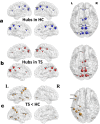Disrupted topological organization of structural networks revealed by probabilistic diffusion tractography in Tourette syndrome children
- PMID: 28474385
- PMCID: PMC6866946
- DOI: 10.1002/hbm.23643
Disrupted topological organization of structural networks revealed by probabilistic diffusion tractography in Tourette syndrome children
Abstract
Tourette syndrome (TS) is a childhood-onset neurobehavioral disorder. Although previous TS studies revealed structural abnormalities in distinct corticobasal ganglia circuits, the topological alterations of the whole-brain white matter (WM) structural networks remain poorly understood. Here, we used diffusion MRI probabilistic tractography and graph theoretical analysis to investigate the topological organization of WM networks in 44 drug-naive TS children and 41 age- and gender-matched healthy children. The WM networks were constructed by estimating inter-regional connectivity probability and the topological properties were characterized using graph theory. We found that both TS and control groups showed an efficient small-world organization in WM networks. However, compared to controls, TS children exhibited decreased global and local efficiency, increased shortest path length and small worldness, indicating a disrupted balance between local specialization and global integration in structural networks. Although both TS and control groups showed highly similar hub distributions, TS children exhibited significant decreased nodal efficiency, mainly distributed in the default mode, language, visual, and sensorimotor systems. Furthermore, two separate networks showing significantly decreased connectivity in TS group were identified using network-based statistical (NBS) analysis, primarily composed of the parieto-occipital cortex, precuneus, and paracentral lobule. Importantly, we combined support vector machine and multiple kernel learning frameworks to fuse multiple levels of network topological features for classification of individuals, achieving high accuracy of 86.47%. Together, our study revealed the disrupted topological organization of structural networks related to pathophysiology of TS, and the discriminative topological features for classification are potential quantitative neuroimaging biomarkers for clinical TS diagnosis. Hum Brain Mapp 38:3988-4008, 2017. © 2017 Wiley Periodicals, Inc.
Keywords: Tourette syndrome; diffusion MRI; graph theory; multiple kernel learning; probabilistic tractography; structural network; topological organization.
© 2017 Wiley Periodicals, Inc.
Figures






Similar articles
-
Combining Disrupted and Discriminative Topological Properties of Functional Connectivity Networks as Neuroimaging Biomarkers for Accurate Diagnosis of Early Tourette Syndrome Children.Mol Neurobiol. 2018 Apr;55(4):3251-3269. doi: 10.1007/s12035-017-0519-1. Epub 2017 May 6. Mol Neurobiol. 2018. PMID: 28478510
-
Probabilistic diffusion tractography and graph theory analysis reveal abnormal white matter structural connectivity networks in drug-naive boys with attention deficit/hyperactivity disorder.J Neurosci. 2013 Jun 26;33(26):10676-87. doi: 10.1523/JNEUROSCI.4793-12.2013. J Neurosci. 2013. PMID: 23804091 Free PMC article.
-
Abnormal topological organization in white matter structural networks revealed by diffusion tensor tractography in unmedicated patients with obsessive-compulsive disorder.Prog Neuropsychopharmacol Biol Psychiatry. 2014 Jun 3;51:39-50. doi: 10.1016/j.pnpbp.2014.01.005. Epub 2014 Jan 16. Prog Neuropsychopharmacol Biol Psychiatry. 2014. PMID: 24440373
-
White Matter-Based Structural Brain Network of Major Depression.Adv Exp Med Biol. 2021;1305:35-55. doi: 10.1007/978-981-33-6044-0_3. Adv Exp Med Biol. 2021. PMID: 33834393 Review.
-
Mapping Structural Connectivity Using Diffusion MRI: Challenges and Opportunities.J Magn Reson Imaging. 2021 Jun;53(6):1666-1682. doi: 10.1002/jmri.27188. Epub 2020 Jun 17. J Magn Reson Imaging. 2021. PMID: 32557893 Free PMC article. Review.
Cited by
-
Deep brain stimulation in Parkinson's disease: analysis of brain fractional anisotropy differences in operated patients.Rev Neurol. 2022 Feb 16;74(4):125-134. doi: 10.33588/rn.7404.2021196. Rev Neurol. 2022. PMID: 35148421 Free PMC article. English, Spanish.
-
Altered Interoceptive Sensibility in Adults With Chronic Tic Disorder.Front Psychiatry. 2022 Jun 21;13:914897. doi: 10.3389/fpsyt.2022.914897. eCollection 2022. Front Psychiatry. 2022. PMID: 35800022 Free PMC article.
-
Altered topological organization of resting-state functional networks in children with infantile spasms.Front Neurosci. 2022 Sep 30;16:952940. doi: 10.3389/fnins.2022.952940. eCollection 2022. Front Neurosci. 2022. PMID: 36248635 Free PMC article.
-
Disrupted small-world networks in children with drug-naïve growth hormone deficiency: a DTI-based network analysis.Quant Imaging Med Surg. 2025 May 1;15(5):4101-4112. doi: 10.21037/qims-24-1927. Epub 2025 Apr 10. Quant Imaging Med Surg. 2025. PMID: 40384693 Free PMC article.
-
Changes in the brain structural connectome after a prospective randomized clinical trial of lithium and quetiapine treatment in youth with bipolar disorder.Neuropsychopharmacology. 2021 Jun;46(7):1315-1323. doi: 10.1038/s41386-021-00989-5. Epub 2021 Mar 22. Neuropsychopharmacology. 2021. PMID: 33753882 Free PMC article. Clinical Trial.
References
-
- Basser PJ, Mattiello J, LeBihan D (1994a): Estimation of the effective self‐diffusion tensor from the NMR spin echo. J Magn Reson Ser B 103:247–254. - PubMed
-
- Basser PJ, Pajevic S, Pierpaoli C, Duda J, Aldroubi A (2000): In vivo fiber tractography using DT‐MRI data. Magn Reson Med 44:625–632. - PubMed
-
- Benjamini Y, Hochberg Y (2015): Controlling the false discovery rate ‐ A practical and powerful approach to multiple testing. J R Stat Soc 57:289–300.
Publication types
MeSH terms
LinkOut - more resources
Full Text Sources
Other Literature Sources
Medical
Research Materials
Miscellaneous

